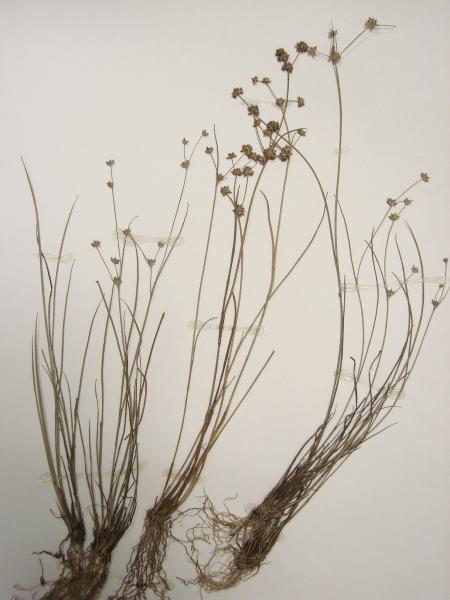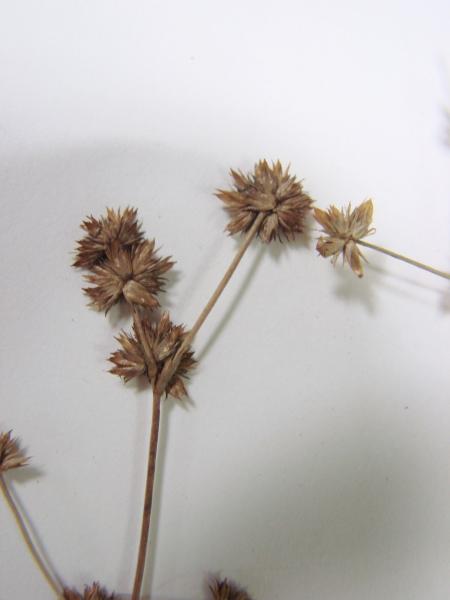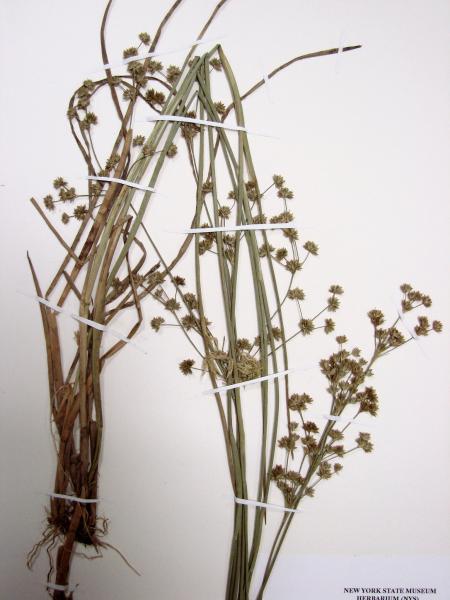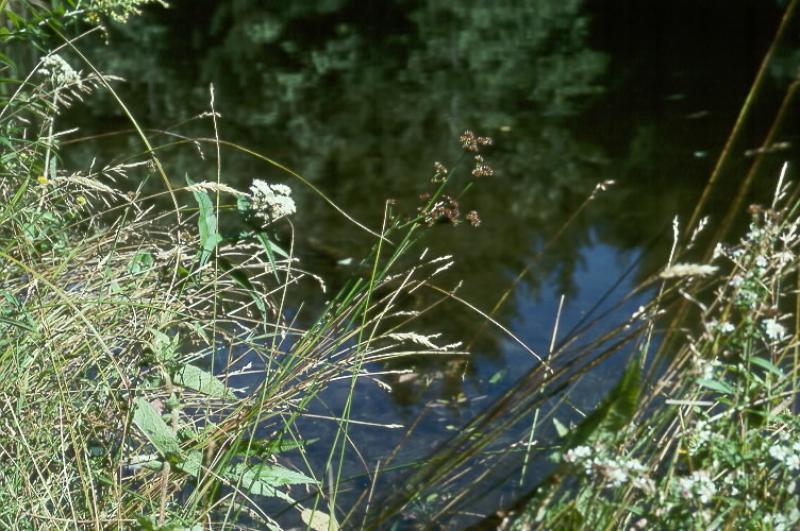Spreading Rush
Juncus subcaudatus (Engelm.) Coville & Blake
- Class
- Monocotyledoneae (Monocots)
- Family
- Juncaceae (Rush Family)
- State Protection
- Endangered
Listed as Endangered by New York State: in imminent danger of extirpation in New York. For animals, taking, importation, transportation, or possession is prohibited, except under license or permit. For plants, removal or damage without the consent of the landowner is prohibited.
- Federal Protection
- Not Listed
- State Conservation Status Rank
- S1
Critically Imperiled in New York - Especially vulnerable to disappearing from New York due to extreme rarity or other factors; typically 5 or fewer populations or locations in New York, very few individuals, very restricted range, very few remaining acres (or miles of stream), and/or very steep declines.
- Global Conservation Status Rank
- G5
Secure globally - Common in the world; widespread and abundant (but may be rare in some parts of its range).
Summary
Did you know?
This species belongs to a group of Juncus with tails on the seeds, but since the tail is shorter than the tail of Canada rush its species name, meaning somewhat tailed, refects that.
State Ranking Justification
There are three existing populations but one of them has no information about condition or numbers. One population is in good condition and one in excellent condition. There are 15 historical occurrences but many of these are from Western Long Island and considered extirpated.
Short-term Trends
The species has been in decline in recent years. About half of the existing populations that were found since 1985 have not been found again because of hydrology changes or habitat alteration. The last new population was found in 1999.
Long-term Trends
This species was never common in New York and many of its historical records from Nassau County are probably gone. The decline in the long-term trend is a result of habitat alteration and hydrology changes in the highly developed areas where it occurs.
Conservation and Management
Threats
Shoreline plants have been threatened by continued high water levels and habitat alteration. One population was crowded out by the invasion of Japanese silver grass (Microstegium vimineum).
Conservation Strategies and Management Practices
Protect the wetland habitat by providing buffers against direct human impact and to protect the hydrology supporting the wetlands.
Research Needs
Research is needed into the environmental factors which limits its distribution. Management techniques for augmenting populations should be studied.
Habitat
Habitat
This species has been collected in a variety of wetland habitats in New York, including forested seeps and small wetlands, streamsides, and the edges of both natural and artificial ponds (New York Natural Heritage Program 2007). Bogs, mossy woods, shaded spring-heads, etc. (Fernald 1970). Swamps and wet shores (Gleason & Cronquist 1991).
Associated Ecological Communities
- Freshwater intertidal mudflats*
(guide)
A sparsely vegetated community characterized by low rosette-leaved aquatics. This community occurs on exposed intertidal mudflats where the water is fresh (salinity less than 0.5 ppt). This community is best developed where mudflats are nearly level so that broad expanses are exposed at low tide. The plants are completely submerged in 0.9 to 1.2 m (3 to 4 ft) of water at high tide and they are usually coated with mud.
- Shallow emergent marsh
(guide)
A marsh meadow community that occurs on soils that are permanently saturated and seasonally flooded. This marsh is better drained than a deep emergent marsh; water depths may range from 6 in to 3.3 ft (15 cm to 1 m) during flood stages, but the water level usually drops by mid to late summer and the soil is exposed during an average year.
* probable association but not confirmed.
Associated Species
- Hypericum
- Juncus acuminatus (sharp-fruited rush)
- Juncus brevicaudatus (narrow-panicled rush)
- Juncus effusus
- Juncus tenuis (path rush)
- Lycopus virginicus (Virginia bugleweed, Virginia water-horehound)
- Schoenoplectus americanus (chair-maker's bulrush)
- Triadenum virginicum
Range
New York State Distribution
In New York Juncus subcaudatus is mainly restricted to Long Island and the Lower Hudson Valley, though there have also been records from Erie and Cattaraugus Counties in the west.
Global Distribution
Juncus subcaudatus is known from Newfoundland and Labrador in Canada, southern New England, and New York, and along the coast to Georgia and Alabama, and inland from Arkansas, Missouri, and the Appalachian states.
Identification Comments
General Description
Woodland Rush is a tufted, grass-like perennial. Its stems are round, smooth, and from 15 to 60 cm tall, and only 1-3mm wide. There are 1-3 leaves along the stem, each from 4 to 15 cm long, septate (partitioned internally), and otherwise similar to the stems. The flowers are borne in heads of 3 to 35 on widely-spreading branches, each head with from 2-10 (20) flowers. As with all rushes, each flower has 6 tepals, or reduced petal-like structures; in J. subcaudatus these are acuminate. The fruit are capsules 3 to 3.8 mm long. Upon ripening these open to expose the seeds, which are .7 to 1.2 mm long with a whitish, translucent covering, and "tails" making up less than 1/2 of their length (FNA 2000).
Best Life Stage for Proper Identification
Fruiting specimens are best for identifying this species.
Similar Species
Juncus canadensis is similar in overall form but has leaves approximately twice as thick, an erect or ascending infloresence, and larger flowers and fruit. J. debilis has seeds only .3 to .4 mm long and lacking the tail and translucent veil of J. subcaudatus seeds (Brooks and Clemants 2000).
Best Time to See
Juncus subcaudatus flowers from mid-June to mid-July, and mature fruits develop from July to early October.
- Fruiting
The time of year you would expect to find Spreading Rush fruiting in New York.
Spreading Rush Images
Taxonomy
Spreading Rush
Juncus subcaudatus (Engelm.) Coville & Blake
- Kingdom Plantae
- Phylum Anthophyta
- Class Monocotyledoneae
(Monocots)
- Order Juncales
- Family Juncaceae (Rush Family)
- Order Juncales
- Class Monocotyledoneae
(Monocots)
- Phylum Anthophyta
Additional Common Names
- Rush
- Woods-rush
Synonyms
- Juncus canadensis var. subcaudatus Engelm.
- Juncus subcaudatus var. subcaudatus [If Juncus subcaudatus var. planisepalus is recognized, then all New York specimens would be recognized as var. subcaudatus. FNA and most other sources do not recognize these varieties. We have chosen to follow this broader treatment.]
Additional Resources
Best Identification Reference
Flora of North America Editorial Committee. 2000. Flora of North America north of Mexico. Vol. 22. Magnoliophyta: Alismatidae, Arecidae, Commelinidae (in part), and Zingiberidae. Oxford Univ. Press, New York. xxiii + 352 pp.
Other References
Clemants, Steven E. 1990. Juncaceae (rush family) of New York State. Contributions to a flora of New York State VII Richard S. Mitchell, ed. New York State Museum Bulletin No. 475. 67 pp.
Crow, Garrett E. and C. Barre Hellquist. 2000. Aquatic and Wetland Plants of Northeastern North America: A revised and enlarged edition of Norman C. Fassett's a Manual of Aquatic Plants. Volume One: Pteridophytes, Gymnosperms, and Angiosperms: Dicotyledons. The University of Wisconsin Press. Madison, Wisconsin. 536 Pages.
Fernald, M.L. 1950. Gray's manual of botany. 8th edition. D. Van Nostrand, New York. 1632 pp.
Gleason, Henry A. and A. Cronquist. 1991. Manual of Vascular Plants of Northeastern United States and Adjacent Canada. The New York Botanical Garden, Bronx, New York. 910 pp.
Holmgren, Noel. 1998. The Illustrated Companion to Gleason and Cronquist's Manual. Illustrations of the Vascular Plants of Northeastern United States and Adjacent Canada. The New York Botanical Garden, Bronx, New York.
New York Natural Heritage Program. 2010. Biotics database. New York Natural Heritage Program. New York State Department of Environmental Conservation. Albany, NY.
New York Natural Heritage Program. 2024. New York Natural Heritage Program Databases. Albany, NY.
Rhoads, Ann F. and Timothy A. Block. 2000. The Plants of Pennsylvania, an Illustrated Manual. University of Pennsylvania Press, Philadelphia, PA.
Weldy, T. and D. Werier. 2010. New York flora atlas. [S.M. Landry, K.N. Campbell, and L.D. Mabe (original application development), Florida Center for Community Design and Research http://www.fccdr.usf.edu/. University of South Florida http://www.usf.edu/]. New York Flora Association http://newyork.plantatlas.usf.edu/, Albany, New York
Weldy, Troy W. and David Werier. 2005. New York Flora Atlas. [S.M. Landry, K.N. Campbell, and L.D. Mabe (original application development), Florida Center for Community Design and Research. University of South Florida]. New York Flora Association, Albany, NY. Available on the web at (http://newyork.plantatlas.usf.edu/).
Links
About This Guide
Information for this guide was last updated on: January 18, 2008
Please cite this page as:
New York Natural Heritage Program. 2024.
Online Conservation Guide for
Juncus subcaudatus.
Available from: https://guides.nynhp.org/spreading-rush/.
Accessed July 26, 2024.




